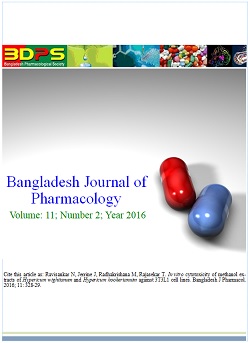In vitro cytotoxicity of methanol extracts of Hypericum wightianum and Hypericum hookerianuim against 3T3L1 cell lines
References
Agostinis P, Vantieghem A, Merlevede W, de Witte PAM. Hypericin in cancer treatment: More light on the way. Int J Biochem Cell Biol. 2002; 34: 221–41.
Rabanal RM, Arias A, Prado B, Hernandez-Perez M, Sanchez-Mateo CC. Antimicrobial studies on three species of Hypericum from the Canary Islands. J Ethnopharmacol. 2002; 81: 287-92.
Rahul C, Thangaraj P. Total phenolic content and anti-radical property of Caralluma diffusa (Wight) N.E. Br. Asian Pac J Trop Biomed. 2012; 1: 1-4.
Shahneh FZ, Valiyari S, Azadmehr A, Hajiaghaee R, Yaripour S, Bandehagh A, et al. Inhibition of growth and induction of apoptosis in fibrosarcoma cell Lines by Echinophora platyloba DC: In vitro analysis. Adv Pharmacol Sci. 2013: 5; 129-31.
Unnikrishnan MC, Ramadasan K. Cytotoxicity of extracts of spices to cultured cells. Nutr Cancer. 1988: 11; 251-57.
Yazaki K, Okada T. Medicinal and aromatic plants. VI. In: Biotechnology in agriculture and forestry. Bajaj YPS (ed.). Vol. 26. Berlin, Springer-Verlag, 1994, pp 167-78.

Apply citation style format of Bangladesh Journal of Pharmacology
Copyright (c) 2016 Narayanan Ravisankar, Joseph Jerrine, Manikkan Radhakrishana, Thirunavukkarasu Rajasekar

This work is licensed under a Creative Commons Attribution 4.0 International License.
